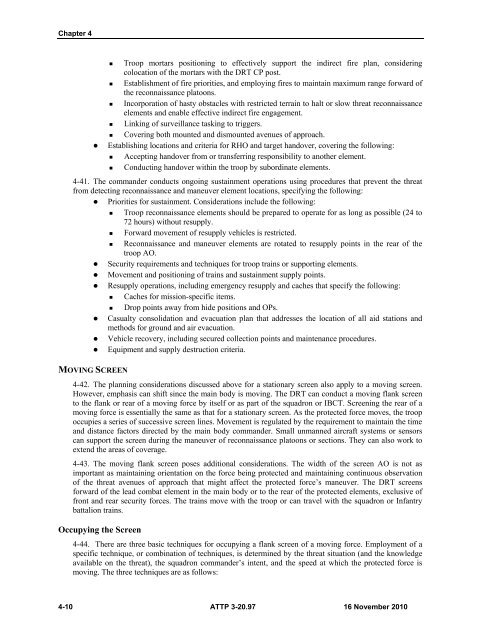Dismounted Reconnaissance Troop - Army Electronic Publications ...
Dismounted Reconnaissance Troop - Army Electronic Publications ...
Dismounted Reconnaissance Troop - Army Electronic Publications ...
Create successful ePaper yourself
Turn your PDF publications into a flip-book with our unique Google optimized e-Paper software.
Chapter 4<br />
<strong>Troop</strong> mortars positioning to effectively support the indirect fire plan, considering<br />
colocation of the mortars with the DRT CP post.<br />
Establishment of fire priorities, and employing fires to maintain maximum range forward of<br />
the reconnaissance platoons.<br />
Incorporation of hasty obstacles with restricted terrain to halt or slow threat reconnaissance<br />
elements and enable effective indirect fire engagement.<br />
Linking of surveillance tasking to triggers.<br />
Covering both mounted and dismounted avenues of approach.<br />
Establishing locations and criteria for RHO and target handover, covering the following:<br />
Accepting handover from or transferring responsibility to another element.<br />
Conducting handover within the troop by subordinate elements.<br />
4-41. The commander conducts ongoing sustainment operations using procedures that prevent the threat<br />
from detecting reconnaissance and maneuver element locations, specifying the following:<br />
Priorities for sustainment. Considerations include the following:<br />
<strong>Troop</strong> reconnaissance elements should be prepared to operate for as long as possible (24 to<br />
72 hours) without resupply.<br />
Forward movement of resupply vehicles is restricted.<br />
<strong>Reconnaissance</strong> and maneuver elements are rotated to resupply points in the rear of the<br />
troop AO.<br />
Security requirements and techniques for troop trains or supporting elements.<br />
Movement and positioning of trains and sustainment supply points.<br />
Resupply operations, including emergency resupply and caches that specify the following:<br />
Caches for mission-specific items.<br />
Drop points away from hide positions and OPs.<br />
Casualty consolidation and evacuation plan that addresses the location of all aid stations and<br />
methods for ground and air evacuation.<br />
Vehicle recovery, including secured collection points and maintenance procedures.<br />
Equipment and supply destruction criteria.<br />
MOVING SCREEN<br />
4-42. The planning considerations discussed above for a stationary screen also apply to a moving screen.<br />
However, emphasis can shift since the main body is moving. The DRT can conduct a moving flank screen<br />
to the flank or rear of a moving force by itself or as part of the squadron or IBCT. Screening the rear of a<br />
moving force is essentially the same as that for a stationary screen. As the protected force moves, the troop<br />
occupies a series of successive screen lines. Movement is regulated by the requirement to maintain the time<br />
and distance factors directed by the main body commander. Small unmanned aircraft systems or sensors<br />
can support the screen during the maneuver of reconnaissance platoons or sections. They can also work to<br />
extend the areas of coverage.<br />
4-43. The moving flank screen poses additional considerations. The width of the screen AO is not as<br />
important as maintaining orientation on the force being protected and maintaining continuous observation<br />
of the threat avenues of approach that might affect the protected force’s maneuver. The DRT screens<br />
forward of the lead combat element in the main body or to the rear of the protected elements, exclusive of<br />
front and rear security forces. The trains move with the troop or can travel with the squadron or Infantry<br />
battalion trains.<br />
Occupying the Screen<br />
4-44. There are three basic techniques for occupying a flank screen of a moving force. Employment of a<br />
specific technique, or combination of techniques, is determined by the threat situation (and the knowledge<br />
available on the threat), the squadron commander’s intent, and the speed at which the protected force is<br />
moving. The three techniques are as follows:<br />
4-10 ATTP 3-20.97 16 November 2010

















